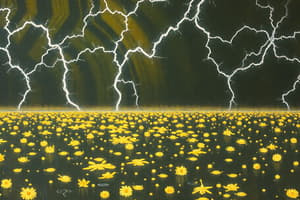Podcast
Questions and Answers
A positive test charge $q_1$ is placed in an electric field. Which of the following statements accurately describes the direction of the electric field?
A positive test charge $q_1$ is placed in an electric field. Which of the following statements accurately describes the direction of the electric field?
- The electric field points towards the location where a negative charge would experience the greatest force.
- The electric field points in the direction of decreasing electric potential.
- There's no electric field. (correct)
- The electric field is directed radially inward towards the positive charge.
The electric field at a distance $r$ from a point charge $q$ is given by $E = \frac{q}{r^2}$. If the charge is doubled and the distance is halved, by what factor does the electric field change?
The electric field at a distance $r$ from a point charge $q$ is given by $E = \frac{q}{r^2}$. If the charge is doubled and the distance is halved, by what factor does the electric field change?
- It increases by a factor of four.
- It increases by a factor of two.
- It increases by a factor of eight. (correct)
- It stays the same.
A conductor is placed in an external electric field and reaches electrostatic equilibrium. What is the magnitude of the electric field inside the conductor?
A conductor is placed in an external electric field and reaches electrostatic equilibrium. What is the magnitude of the electric field inside the conductor?
- Zero. (correct)
- Varies depending on the shape of the conductor.
- Equal to the external applied field.
- Non-zero, but constant throughout the conductor.
What is the electric field inside a uniformly charged spherical shell?
What is the electric field inside a uniformly charged spherical shell?
Under what conditions do charges move in a conductor?
Under what conditions do charges move in a conductor?
Which statement best describes the principle of conservation of charge?
Which statement best describes the principle of conservation of charge?
Which condition must be met for a system to be considered electrically neutral?
Which condition must be met for a system to be considered electrically neutral?
According to Gauss's Law, how does the electric flux through a closed surface surrounding a point charge depend on the size of the surface?
According to Gauss's Law, how does the electric flux through a closed surface surrounding a point charge depend on the size of the surface?
A neutral object is brought near a charged object. What phenomenon primarily explains the interaction between them?
A neutral object is brought near a charged object. What phenomenon primarily explains the interaction between them?
The electrostatic force between two point charges is 0.5 N, and the distance between them is 4 meters. If one of the charges has a magnitude of 2 C, what is the magnitude of the other charge?
The electrostatic force between two point charges is 0.5 N, and the distance between them is 4 meters. If one of the charges has a magnitude of 2 C, what is the magnitude of the other charge?
Flashcards
Electric field of positive test charge q1
Electric field of positive test charge q1
There is no electric field around a positive test charge.
Effect on electric field strength
Effect on electric field strength
It increases by a factor of eight when the charge is doubled and the distance is halved, according to the equation E=kq/r^2.
Electric field inside conductor
Electric field inside conductor
The electric field inside a conductor is zero when it reaches electrostatic equilibrium.
Electric field inside charged sphere
Electric field inside charged sphere
Signup and view all the flashcards
Charge Movement in Conductors
Charge Movement in Conductors
Signup and view all the flashcards
Electrical Neutrality
Electrical Neutrality
Signup and view all the flashcards
Gauss's Law.
Gauss's Law.
Signup and view all the flashcards
Connected Conductors
Connected Conductors
Signup and view all the flashcards
Quantization of electric charge
Quantization of electric charge
Signup and view all the flashcards
Neutral object near charged object
Neutral object near charged object
Signup and view all the flashcards
Study Notes
- A positive test charge q1's electric field has no direction
- When the charge doubles and the distance is halved, the electric field increases by a factor of eight, given E = q/R^2 where q is charge and R is distance.
- A conductor in an electric field at electrostatic equilibrium has an electric field of zero inside
- The electric field inside a uniformly charged spherical shell is zero at all points inside
- In a conductor, charges move only when an electric field is applied
- The principle of conservation of charge states the total charge in a closed system is constant
- For a system to be electrically neutral, the number of positive charges must equal the number of negative charges
- According to Gauss's Law, the electric flux through a closed surface surrounding a point charge is independent of the size of the surface
- A neutral object near a charged object becomes polarized
- Electric charge can only exist in integer multiples of fundamental charge due to the quantization of electric charge
- Two conductors connected by a conducting wire exchange charge to reach an equal potential
- If the electrostatic force is 0.5 N, the distance is 4 meters, and one charge is 2µC, the magnitude of the other charge is 4µC
Studying That Suits You
Use AI to generate personalized quizzes and flashcards to suit your learning preferences.




